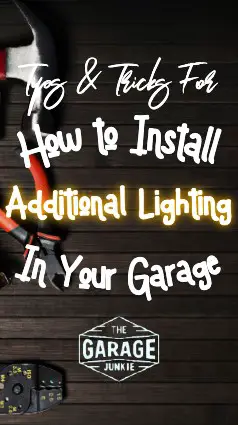One of the most commonly asked questions we get here at The Garage Junkie (aside from wanting to know if we’re available to help clean out your garage) is how to add additional lighting to a garage’s existing set-up. This is an understandable request, as most garages are notorious for being dark and sparsely lit. Luckily for you, we have compiled our best tips and tricks that are guaranteed to bring some brightness to even the darkest of garages.
Installing additional lighting in your garage will require you to make three crucial decisions. First, figure out how much light, or lumens, you are getting out of your garage’s existing set-up. Second, think about why you would like additional light and calculate how much extra light you will need. Lastly, consider how intensive of an installation process you are willing and able to commit yourself to and get to work!

How to Calculate Your Garage’s Existing Light Output
Before you start adding lights to your garage it’s best to know how much light your garage’s existing fixtures are producing themselves. To be able to do this you will need to know more about your lights’ lumens and watts. Confused? Don’t worry, we will break down all the technical jargon below.
Lumens is the technical term used when measuring the brightness that a specific lightbulb can produce. This is different from a bulb’s wattage (better known as watts) which is a measure of how much energy or electricity it needs over the time it’s being used.
So, now that we know what we are looking for, how can you tell what your existing space’s lumen output is? Well, one way to do so quickly and easily is to use a handheld light meter like this one from URCERI. Not only will using a light meter give you a true measure of the amount of light your existing fixtures produce, but you will also be able to measure other key details such as the temperature quality of the light.
Using a light meter is a fool-proof and inexpensive method of getting your garage’s number of lumens, but if you would rather calculate your garage’s luminosity manually, that is also an option. Calculating your garage’s brightness will require you to know how many lumens each lightbulb produces individually and add them together in order to get the total brightness produced.
To help in this process the following watt to lumens conversions can be a rough (but useful) tool:
Incandescent Lights:
40 Watts = 450 Lumens
60 Watts = 800 Lumens
75 Watts = 1100 Lumens
100 Watts = 1600 Lumens
CFL:
8-9 Watts = 450 Lumens
13-14 Watts = 800 Lumens
18-19 Watts = 1100 Lumens
23 Watts = 1600 Lumens
LED:
6 Watts = 450 Lumens
9-10 Watts = 800 Lumens
13 Watts = 1100 Lumens
16-18 Watts = 1600 Lumens
How Much Additional Light Might You Need for Your Garage?
Now that you know how much light is already being produced in your garage, it’s time to figure out how this compares to what your space needs. One way to do this is by using a handy lumen calculator, like this free one from OMNI Calculator.
In order to properly utilize such a calculator, you will generally need to input a few pieces of information, like the square footage of your area and the type of space it is. The square footage can be easily obtained by multiplying your garage’s length and width and the OMNI calculator already has a preset for garages in its drop-down menu. Once you have inputted all of your data, the calculator should give a good idea of how much additional light you should expect to need for your particular garage.
What Type of Installation Process is Right for You and Your Garage Space?
Once you have all the boring calculations out of the way, and you have an idea of what your garage’s lighting needs are, it’s time for the fun part, getting more light into your garage! The process of doing so can be as intensive of an installation as you desire. Below we will discuss how to do so by either hard-wiring new fixtures into your garage’s circuitry or by simply upgrading the lights you already have.
Best Practices When Wiring Electrical for Lighting
Wiring additional lighting to your garage’s existing circuitry is easiest to do if your garage is still unfinished. This is because messing with the wiring of a finished garage will often require you to do at least some work within your garage’s drywall or ceiling. While this doesn’t mean you will need to take out an entire wall by any means, it does figure that some additional patching and painting will likely be required when your wiring job is finished.
Other things to consider when attempting your own wiring include:
- When undertaking any electrical work, it’s always best-and safest-to turn off all electrical current into your home at your main circuit breaker box; this is done in order to minimize the risk of electrocution.
- Make sure you have the right tools for the job, like a stud finder and a quality voltage meter (for safety reasons).
- Wires should never span multiple joists or studs.
- As tempting as it may be to do so; never wire over the top of a wall.
- Make sure all wiring is installed snuggly to your studs.
- Most new fixtures can be easily added to existing wiring by connecting the wires using a junction box, like this one from LaMotech, which comes in a variety of sizes to fit your space easily.
- Make sure to properly measure and plan out where you will be installing before you start so that you can ensure you have the proper lengths of electrical wire etc., this will save you a lot of headaches later.
- If your garage is unfinished, the simplest way to install new wiring is to follow your garage’s existing framing. This will help in ensuring that all switches, lights and outlet boxes are along your vertical studs.
Utilizing Existing Light Fixtures in Your Garage
If the task of installing new fixtures into your garage’s circuitry sounds like a daunting task, have no fear; there are plenty of ways to add additional lighting without having to go through the trouble of messing with your garage’s internal structures and electrical wiring. Most commonly this can be accomplished by simply upgrading the lightbulbs in your existing fixtures.
Swapping out an incandescent bulb for LEDs is an easy way to provide more lumens for less wattage. When doing so, all you will typically need to know is what type of socket your existing fixture is utilizing. The best part is that your new lights will often come with helpful new features such as lamps with an adjustable range of motion or color temperature changing abilities. One example of just such a bulb would be this model from Tanbaby, which screws into any typical E26 or E27 base.
Other options include adding additional lighting through the use of portable lamps for purposes such as task lighting. For example, if you find yourself struggling with the light around your work bench, consider adding a swing-arm lamp (like this one from AmazLit, that comes with a handy clamp base) which will allow you to precisely control the additional lumens you are using.
Conclusion
And there you have it! We’ve discussed everything you need to know to properly calculate your garage’s existing lighting capabilities and figure out how much additional lighting is required. We’ve discussed different types of fixture installations you can undertake and some best practices on how to do so yourself. We hope you have had fun and learned something new along the way. As always, keep it tuned to The Garage Junkie for all your Garage’s FIY and DIY needs!
